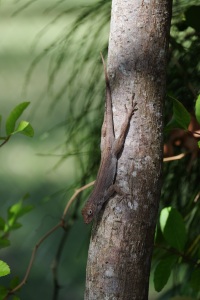Embryos Don’t Mind the Heat [repost]
[Repost from Anole annals]
[caption id=“attachment_416” align=“alignright” width=“268”]

Walking down “Red Road” in Pinecrest neighborhood of Miami, FL, it is hard to miss a myriad of lizards on trees and street lamps. Among the many city-dwelling residents, the Cuban brown anole (A. sagrei) and the Puerto Rican crested anole (A. cristatellus) are seen virtually everywhere. While there are evidences that anoles are adapting to urban landscapes, most of past studies have focused on adult stages (Kolbe et al., 2012; Winchell et al., 2016; Lapiedra et al., 2017) and early life stages have been largely ignored. Our recently published study was the first to address how adaptation in the embryonic stage could facilitate establishment of populations in cities.
The transformation of natural habitats into urban landscapes dramatically alters thermal environments, which in turn, can impact local biota. For ectothermic organisms that are oviparous (like anoles), developing embryos are particularly sensitive to these altered environments because they cannot behaviourally thermoregulate and are largely left to the mercy of their surrounding environment. Yet, we know little about how thermal environments in urban and forested areas affect embryo development and hatchling phenotypes.
To determine if embryos from urban and forested sites are adapted to their respective thermal environments, we incubated eggs with temperature regimes that mimic likely nest conditions in both urban and forested environments. Our results showed that for two species (A. sagrei and A cristatellus), urban thermal environments accelerated development, but had no impact on egg survival or any hatchling phenotypic traits measured (including body size, running performance, and locomotor behaviour). Furthermore, our results showed no evidence that embryos from either habitat are adapted to their respective thermal environments. Rather, this lack of major effects suggests that both anole species are physiologically robust to novel environments. This may explain their success in establishing populations in human-modified landscapes.